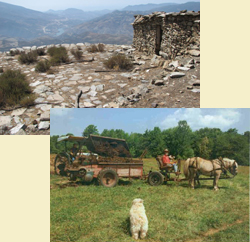« Visioning County Food Production – Part Five | Home | What Every Marxist Needs to Know about Ecology »
On Invasives
By Karl North | November 18, 2010
What I will say here about the issue of invasives may seem picky, but it is not, because it points up a fundamental flaw in how we think about any intervention into the complex, systemic world in which we live.
The flaw running through the whole discourse about invasives is the tendency to see them too simply, and, in particular, in too short a time frame. In the longer, holistic view, all species are historically invasives, including humans. As my current bumper sticker says in protest against the wall at the US/Mexican border, “We are all resident aliens”. In fact, any innovation or other intervention in a complex system (like an organic farmer buying a Kubota tractor) is initially an invasive.
It is true that, driven by temporary fossil energy, accelerated social change has in turn accelerated the spread of species into new environments. But to approach the issue holistically we need to ask: What is it about the invasive that is counterproductive? Often it is not a quality inherent in the “invasive”, but how fast the system is forced to adapt. If the ecosystem (or its management team) has time to adapt, to develop counterbalancing forces, a new entry may not destabilize it, and may contribute positive functions in the sense of moving the whole toward our management goals. We also need to ask: What are the ripple effects of the invasion or intervention – how the system is affected in multiple ways over time? Are there ways to adapt the whole so that benefits outweigh costs?
For example. Rats are usually seen as an unmitigated evil invasive that, at their worst brought the plagues that decimated the urban societies of medieval Europe. But the rat population on my farm is kept under control by farm dogs and barn cats. The dogs and cats provide other positive services on the farm, and the rats support the dog and cat population by adding essential animal protein to their diets. So, are the rats really “invasives”?
To generalize, if the intervention involves a new species (as opposed to a new technology) we can sometimes apply nature’s management tools to maintain system dynamic equilibrium. One is to make sure a predator species population is sufficient to control the new species population. Another is to populate the ecological niche of the new species with a competitor species, with the same effect of population control of the new species.
The ultimate take home lesson of this essay is that whether to deal with an unintended “invasion” or a deliberate intervention or technological “innovation”, a system manager to ask the same holistic questions: What are the consequences over time, in the long term and in other parts of the system? Do “solutions” address root causes that are often structural, or mainly symptoms? And the classic, crucial, sociological question: cui bono – who ultimately benefits most?
Topics: Agriculture, Northland Sheep Dairy, Systems Thinking Tools | No Comments »
